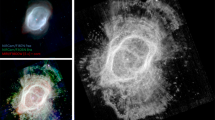Abstract
The discovery of planets in orbit around the pulsar PSR1257+12 (ref. 1) shows that planets may form around post-main-sequence stars2. Other evolved stars, such as HD44179 (an evolved star which is part of the binary system that has expelled the gas and dust that make the Red Rectangle nebula), possess gravitationally bound orbiting dust disks3,4. It is possible that planets might form from gravitational collapse in such disks5. Here we report high-angular-resolution observations at millimetre and submillimetre wavelengths of the dusk disk associated with the Red Rectangle. We find a dust clump with an estimated mass near that of Jupiter in the outer region of the disk. The clump is larger than our Solar System, and far beyond where planet formation would normally be expected, so its nature is at present unclear.
This is a preview of subscription content, access via your institution
Access options
Subscribe to this journal
Receive 51 print issues and online access
$199.00 per year
only $3.90 per issue
Buy this article
- Purchase on Springer Link
- Instant access to full article PDF
Prices may be subject to local taxes which are calculated during checkout


Similar content being viewed by others
References
Wolszczan, A. & Frail, D. A. Aplanetary system around the millisecond pulsar PSR 1257+12. Nature 355, 145–147 (1992).
Banit, M., Ruderman, M. A., Shaham, J. & Applegate, J. H. Formation of planets around pulsars. Astrophys. J. 415, 779–796 (1993).
Jura, M., Balm, S. P. & Kahane, C. Along-lived disk around the Red Rectangle? Astrophys. J. 453, 721–726 (1995).
Waters, L. B. F. M., Waelkens, C., Mayor, M. & Trams, N. R. Amodel for the 89 Herculis system. Astron. Astrophys. 269, 242–248 (1993).
Kolykhalov, P. I. & Syunyaev, R. A. The outer parts of the accretion disks around supermassive black holes in galaxy nuclei and quasars. Sov. Astron. Lett. 6, 357–361 (1981).
Cohen, M.et al. The peculiar object HD 44179 “The Red Rectangle”. Astrophys. J. 196, 179–189 (1975).
Sitko, M. L. Spectral energy distributions of hot stars with circumstellar dust. Astrophys. J. 247, 1024–1038 (1981).
Waelkens, C., van Winckel, H., Waters, L. B. F. M. & Bakker, E. J. Variability and nature of the Red Rectangle nebula. Astron. Astrophys. 314, L17–L20 (1996).
Mathis, J. S. & Lamers, H. J. G. L. M. The origin of the extremely metal-poor post-AGB stars. Astron. Astrophys. 259, L39–L42 (1992).
Waters, L. B. F. M., Trams, N. R. & Waelkens, C. Ascenario for the selective depletion of stellar atmospheres. Astron. Astrophys. 262, L37–L40 (1992).
Roddier, F., Roddier, C., Graves, J. E. & Northcott, M. J. Adaptive optics imaging of proto-planetary nebulae: frosty Leo and the Red Rectangle. Astrophys. J. 443, 249–260 (1995).
Cruzalebes, P., Tessier, E., Lopez, B., Eckart, A. & Tiphene, D. Diffraction limited near-infrared imaging of the Red Rectangle by bispectral analysis. Astron. Astrophys. Suppl. 116, 597–610 (1996).
Jura, M., Turner, J. & Balm, S. P. Big grains in the Red Rectangle? Astrophys. J. 474, 741–748 (1997).
Waters, L. B. F. M.et al. An oxygen-rich dust disk surrounding an evolved star in the Red Rectangle. Nature 391, 868–871 (1998).
Waelkens, C., Van Winckel, H., Trams, N. R. & Waters, L. B. F. M. High-resolution spectroscopy of the central star of the Red-Rectangle nebula. Astron. Astrophys. 256, L15–L18 (1992).
Artymowicz, P., Clarke, C. J., Lubow, S. H. & Pringle, J. E. The effect of an external disk on the orbital elements of a central binary. Astrophys. J. 370, L35–L38 ((1991)).
Hora, J. L., Deutsch, L. K., Hoffmann, W. F. & Fazio, G. G. Mid-infrared imaging of the bipolar nebulae AFGL 618, AFGL 2688, and AFGL 915. Astron. J. 112, 2064–2075 (1996).
van der Veen, W. E. C. J., Waters, L. B. F. M., Trams, N. R. & Matthews, H. E. Astudy of dust shells around high latitude supergiants. Astron. Astrophys. 285, 551–564 (1994).
Greaves, J. S. & Holland, W. S. High mass-loss carbon stars and the evolution of the local 12C/13C ratio. Astron. Astrophys. 327, 342–348 (1997).
Walmsley, C. M., Chini, R., Steppe, H., Forveille, T. & Omont, A. 1.3 mm continuum emission from circumstellar envelopes. Astron. Astrophys. 248, 555–562 (1991).
Smail, I., Ivison, R. J. & Blain, A. W. Adeep submillimeter survey of lensing clusters; a new window on galaxy formation and evolution. Astrophys. J. 490, L5–L8 (1997).
Lopez, B., Tessier, E., Cruzalebes, P., Lefevre, J. & Le Bertre, T. Dust envelope modelling of the Red Rectangle nebula. Astron. Astrophys. 322, 868–877 (1997).
Pollack, J. B.et al. Composition and radiative properties of grains in molecular clouds and accretion disks. Astrophys. J. 421, 615–639 (1994).
Jura, M., Kahane, C., Fischer, D. & Grady, C. Circumstellar gas in the wide binary HD 188037. Astrophys. J. 485, 341–349 (1997).
Olofsson, H., Eriksson, K., Gustafsson, B. & Carlstrom, U. Astudy of circumstellar envelopes around bright carbon stars. Astrophys. J. Suppl. 87, 267–330 (1993).
Acknowledgements
We thank G. Sandell of the JCMT for performing the service observations, the staff at the Owens Valley Radio Observatory, S. Van Dyk and R. Hurt for help with the imaging, and A. Ghez and B. Zuckerman for comments. J.T. was supported by the NSF, and M.J. was supported by NASA.
Author information
Authors and Affiliations
Corresponding author
Rights and permissions
About this article
Cite this article
Jura, M., Turner, J. A mysterious dust clump in a disk around an evolved binary star system. Nature 395, 144–145 (1998). https://doi.org/10.1038/25938
Received:
Accepted:
Issue Date:
DOI: https://doi.org/10.1038/25938
Comments
By submitting a comment you agree to abide by our Terms and Community Guidelines. If you find something abusive or that does not comply with our terms or guidelines please flag it as inappropriate.



